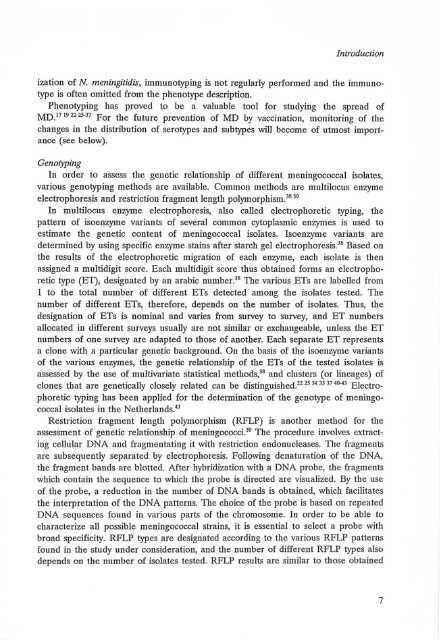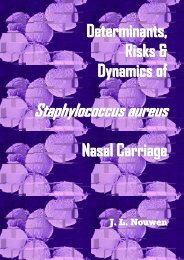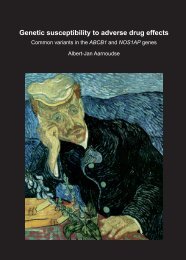An attempt at an epidemiological explanation - Epib.nl
An attempt at an epidemiological explanation - Epib.nl
An attempt at an epidemiological explanation - Epib.nl
- No tags were found...
You also want an ePaper? Increase the reach of your titles
YUMPU automatically turns print PDFs into web optimized ePapers that Google loves.
Introductioniz<strong>at</strong>ion of N. meningitidis, immunotyping is not regularly performed <strong>an</strong>d the immunotypeis often omitted from the phenotype description.Phenotyping has proved to be a valuable tool for studying the spread ofMD!' 19 22 2$.31 For the future prevention of MD by vaccin<strong>at</strong>ion, monitoring of thech<strong>an</strong>ges in the distribution of serotypes <strong>an</strong>d subtypes will become of utmost import<strong>an</strong>ce(see below) .GenotypingIn order to assess the genetic rel<strong>at</strong>ionship of different meningococcal isol<strong>at</strong>es,various genotyping methods are available. Common methods are muItilocus enzymeelectrophoresis <strong>an</strong>d restriction fragment length polymorphism." 39In multilocus enzyme electrophoresis, also called electrophoretic typing, thep<strong>at</strong>tern of isoenzyme vari<strong>an</strong>ts of several common cytoplasmic enzymes is used toestim<strong>at</strong>e the genetic content of meningococcal isol<strong>at</strong>es. Isoenzyme vari<strong>an</strong>ts aredetermined by using specific enzyme stains after starch gel electrophoresis." Based onthe results of the electrophoretic migr<strong>at</strong>ion of each enzyme, each isol<strong>at</strong>e is thenassigned a multidigit score. Each multidigit score thus obtained forms <strong>an</strong> electrophoretictype (ET), design<strong>at</strong>ed by <strong>an</strong> arabic number." The various ETs are labelled from1 to the total number of different ETs detected among the isol<strong>at</strong>es tested. Thenumber of different ETs, therefore, depends on the number of isol<strong>at</strong>es. Thus, thedesign<strong>at</strong>ion of ETs is nominal <strong>an</strong>d varies from survey to survey, <strong>an</strong>d ET numbersalloc<strong>at</strong>ed in different surveys usually are not similar or exch<strong>an</strong>geable, u<strong>nl</strong>ess the ETnumbers of one survey are adapted to those of <strong>an</strong>other. Each separ<strong>at</strong>e ET representsa clone with a particular genetic background. On the basis of the isoenzyme vari<strong>an</strong>tsof the various enzymes, the genetic rel<strong>at</strong>ionship of the ETs of the tested isol<strong>at</strong>es isassessed by the use of multivari<strong>at</strong>e st<strong>at</strong>istical methods," <strong>an</strong>d clusters (or lineages) ofclones th<strong>at</strong> are genetically closely rel<strong>at</strong>ed c<strong>an</strong> he distinguished." 2S '053740·43 Electrophoretictyping has been applied for the determin<strong>at</strong>ion of the genotype of meningococcalisol<strong>at</strong>es in the Netherl<strong>an</strong>ds"Restriction fragment length polymorphism (RFLP) is <strong>an</strong>other method for theassessment of genetic rel<strong>at</strong>ionship of meningococci. 39 The procedure involves extractingcellular DNA <strong>an</strong>d fragment<strong>at</strong>ing it with restriction endonucleases. The fragmentsare subsequently separ<strong>at</strong>ed by electrophoresis. Following den<strong>at</strong>ur<strong>at</strong>ion of the DNA,the fragment b<strong>an</strong>ds are blotted. After hybridiz<strong>at</strong>ion with a DNA probe, the fragmentswhich contain the sequence to which the probe is directed are visua lized. By the useof the probe, a reduction in the number of DNA b<strong>an</strong>ds is obtained, which facilit<strong>at</strong>esthe interpret<strong>at</strong>ion of the DNA p<strong>at</strong>terns. The choice of the probe is based on repe<strong>at</strong>edDNA sequences found in various parts of the chromosome. In order to be able tocharacterize all possible meningococcal strains, it is essential to select a probe withbroad specificity. RFLP types are design<strong>at</strong>ed according to the various RFLP p<strong>at</strong>ternsfound in the study under consider<strong>at</strong>ion, <strong>an</strong>d the number of different RFLP types alsodepends on the number of isol<strong>at</strong>es tested. RFLP results are similar to those obtained7









